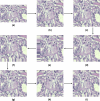An explainable AI-driven deep neural network for accurate breast cancer detection from histopathological and ultrasound images
- PMID: 40394112
- PMCID: PMC12092800
- DOI: 10.1038/s41598-025-97718-5
An explainable AI-driven deep neural network for accurate breast cancer detection from histopathological and ultrasound images
Abstract
Breast cancer represents a significant global health challenge, which makes it essential to detect breast cancer early and accurately to improve patient prognosis and reduce mortality rates. However, traditional diagnostic processes relying on manual analysis of medical images are inherently complex and subject to variability between observers, highlighting the urgent need for robust automated breast cancer detection systems. While deep learning has demonstrated potential, many current models struggle with limited accuracy and lack of interpretability. This research introduces the Deep Neural Breast Cancer Detection (DNBCD) model, an explainable AI-based framework that utilizes deep learning methods for classifying breast cancer using histopathological and ultrasound images. The proposed model employs Densenet121 as a foundation, integrating customized Convolutional Neural Network (CNN) layers including GlobalAveragePooling2D, Dense, and Dropout layers along with transfer learning to achieve both high accuracy and interpretability for breast cancer diagnosis. The proposed DNBCD model integrates several preprocessing techniques, including image normalization and resizing, and augmentation techniques to enhance the model's robustness and address class imbalances using class weight. It employs Grad-CAM (Gradient-weighted Class Activation Mapping) to offer visual justifications for its predictions, increasing trust and transparency among healthcare providers. The model was assessed using two benchmark datasets: Breakhis-400x (B-400x) and Breast Ultrasound Images Dataset (BUSI) containing 1820 and 1578 images, respectively. We systematically divided the datasets into training (70%), testing (20%,) and validation (10%) sets, ensuring efficient model training and evaluation obtaining accuracies of 93.97% for B-400x dataset having benign and malignant classes and 89.87% for BUSI dataset having benign, malignant, and normal classes for breast cancer detection. Experimental results demonstrate that the proposed DNBCD model significantly outperforms existing state-of-the-art approaches with potential uses in clinical environments. We also made all the materials publicly accessible for the research community at: https://github.com/romzanalom/XAI-Based-Deep-Neural-Breast-Cancer-Detection .
Keywords: BUSI; Breakhis-400x; Breast cancer; CNN; DNBCD; Grad-CAM; Transfer learning; XAI.
© 2025. The Author(s).
Conflict of interest statement
Declarations. Competing interests: The authors declare no competing interests.
Figures




























Similar articles
-
Revolutionizing breast ultrasound diagnostics with EfficientNet-B7 and Explainable AI.BMC Med Imaging. 2024 Sep 2;24(1):230. doi: 10.1186/s12880-024-01404-3. BMC Med Imaging. 2024. PMID: 39223507 Free PMC article.
-
Brain tumor segmentation and detection in MRI using convolutional neural networks and VGG16.Cancer Biomark. 2025 Mar;42(3):18758592241311184. doi: 10.1177/18758592241311184. Epub 2025 Apr 4. Cancer Biomark. 2025. PMID: 40183298
-
ResViT FusionNet Model: An explainable AI-driven approach for automated grading of diabetic retinopathy in retinal images.Comput Biol Med. 2025 Mar;186:109656. doi: 10.1016/j.compbiomed.2025.109656. Epub 2025 Jan 16. Comput Biol Med. 2025. PMID: 39823821
-
Deep learning approaches for breast cancer detection in histopathology images: A review.Cancer Biomark. 2024;40(1):1-25. doi: 10.3233/CBM-230251. Cancer Biomark. 2024. PMID: 38517775 Free PMC article. Review.
-
Breast Cancer Detection Using Convolutional Neural Networks: A Deep Learning-Based Approach.Cureus. 2025 May 3;17(5):e83421. doi: 10.7759/cureus.83421. eCollection 2025 May. Cureus. 2025. PMID: 40322605 Free PMC article. Review.
References
-
- Bray, F. et al. Global cancer statistics 2022: Globocan estimates of incidence and mortality worldwide for 36 cancers in 185 countries. CA Cancer J. Clin.74, 229–263 (2024). - PubMed
-
- Organization, W. H. World health organization (who) — https://www.who.int/ (2024). [Accessed 20-08-2024].
-
- Foundation, N. B. C. Breast cancer facts & stats 2024 - incidence, age, survival, & more. https://www.nationalbreastcancer.org/breast-cancer-facts/#~: (2024). [Accessed 08-08-2024].
-
- Breastcancer.org. Breast cancer facts and statistics 2024 — breastcancer.org. https://www.breastcancer.org/facts-statistics (2024). [Accessed 08-08-2024].
-
- for Biotechnology Information, N. C. Breast cancer early detection: a phased approach to implementation. https://www.ncbi.nlm.nih.gov/pmc/articles/PMC7237065/ (2024). [Accessed 08-08-2024].
MeSH terms
Grants and funding
LinkOut - more resources
Full Text Sources
Medical

